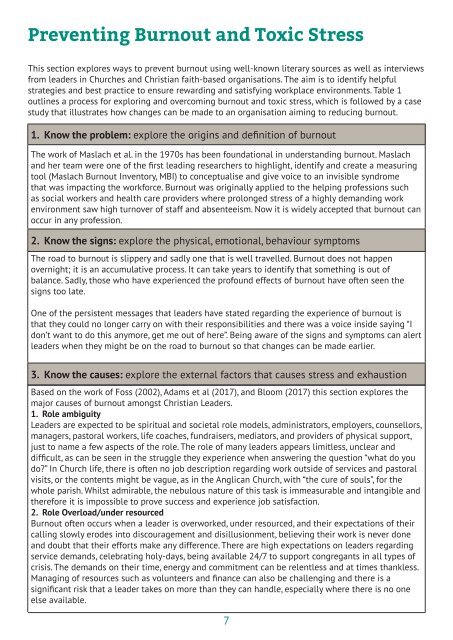Burnout in Churches and Christian Faith-Based Organisations
Burnout is a “syndrome of emotional exhaustion, depersonalization and reduced personal accomplishment that can occur among individuals who work with people in some capacity (Maslach 1996:193). This definition, whilst helpful, fails to convey the potentially life-shattering impact that burnout can have, as described in the words of ‘Peter’, a Christian leader who contributed to this guidance.
Burnout is a “syndrome of emotional exhaustion, depersonalization and reduced personal accomplishment that can occur among individuals who work with people in some capacity (Maslach 1996:193).
This definition, whilst helpful, fails to convey the potentially life-shattering impact that burnout can have, as described in the words of ‘Peter’, a Christian leader who contributed to this guidance.
You also want an ePaper? Increase the reach of your titles
YUMPU automatically turns print PDFs into web optimized ePapers that Google loves.
Prevent<strong>in</strong>g <strong>Burnout</strong> <strong>and</strong> Toxic Stress<br />
This section explores ways to prevent burnout us<strong>in</strong>g well-known literary sources as well as <strong>in</strong>terviews<br />
from leaders <strong>in</strong> <strong>Churches</strong> <strong>and</strong> <strong>Christian</strong> faith-based organisations. The aim is to identify helpful<br />
strategies <strong>and</strong> best practice to ensure reward<strong>in</strong>g <strong>and</strong> satisfy<strong>in</strong>g workplace environments. Table 1<br />
outl<strong>in</strong>es a process for explor<strong>in</strong>g <strong>and</strong> overcom<strong>in</strong>g burnout <strong>and</strong> toxic stress, which is followed by a case<br />
study that illustrates how changes can be made to an organisation aim<strong>in</strong>g to reduc<strong>in</strong>g burnout.<br />
1. Know the problem: explore the orig<strong>in</strong>s <strong>and</strong> def<strong>in</strong>ition of burnout<br />
The work of Maslach et al. <strong>in</strong> the 1970s has been foundational <strong>in</strong> underst<strong>and</strong><strong>in</strong>g burnout. Maslach<br />
<strong>and</strong> her team were one of the first lead<strong>in</strong>g researchers to highlight, identify <strong>and</strong> create a measur<strong>in</strong>g<br />
tool (Maslach <strong>Burnout</strong> Inventory, MBI) to conceptualise <strong>and</strong> give voice to an <strong>in</strong>visible syndrome<br />
that was impact<strong>in</strong>g the workforce. <strong>Burnout</strong> was orig<strong>in</strong>ally applied to the help<strong>in</strong>g professions such<br />
as social workers <strong>and</strong> health care providers where prolonged stress of a highly dem<strong>and</strong><strong>in</strong>g work<br />
environment saw high turnover of staff <strong>and</strong> absenteeism. Now it is widely accepted that burnout can<br />
occur <strong>in</strong> any profession.<br />
2. Know the signs: explore the physical, emotional, behaviour symptoms<br />
The road to burnout is slippery <strong>and</strong> sadly one that is well travelled. <strong>Burnout</strong> does not happen<br />
overnight; it is an accumulative process. It can take years to identify that someth<strong>in</strong>g is out of<br />
balance. Sadly, those who have experienced the profound effects of burnout have often seen the<br />
signs too late.<br />
One of the persistent messages that leaders have stated regard<strong>in</strong>g the experience of burnout is<br />
that they could no longer carry on with their responsibilities <strong>and</strong> there was a voice <strong>in</strong>side say<strong>in</strong>g “I<br />
don’t want to do this anymore, get me out of here”. Be<strong>in</strong>g aware of the signs <strong>and</strong> symptoms can alert<br />
leaders when they might be on the road to burnout so that changes can be made earlier.<br />
3. Know the causes: explore the external factors that causes stress <strong>and</strong> exhaustion<br />
<strong>Based</strong> on the work of Foss (2002), Adams et al (2017), <strong>and</strong> Bloom (2017) this section explores the<br />
major causes of burnout amongst <strong>Christian</strong> Leaders.<br />
1. Role ambiguity<br />
Leaders are expected to be spiritual <strong>and</strong> societal role models, adm<strong>in</strong>istrators, employers, counsellors,<br />
managers, pastoral workers, life coaches, fundraisers, mediators, <strong>and</strong> providers of physical support,<br />
just to name a few aspects of the role. The role of many leaders appears limitless, unclear <strong>and</strong><br />
difficult, as can be seen <strong>in</strong> the struggle they experience when answer<strong>in</strong>g the question “what do you<br />
do?” In Church life, there is often no job description regard<strong>in</strong>g work outside of services <strong>and</strong> pastoral<br />
visits, or the contents might be vague, as <strong>in</strong> the Anglican Church, with “the cure of souls”, for the<br />
whole parish. Whilst admirable, the nebulous nature of this task is immeasurable <strong>and</strong> <strong>in</strong>tangible <strong>and</strong><br />
therefore it is impossible to prove success <strong>and</strong> experience job satisfaction.<br />
2. Role Overload/under resourced<br />
<strong>Burnout</strong> often occurs when a leader is overworked, under resourced, <strong>and</strong> their expectations of their<br />
call<strong>in</strong>g slowly erodes <strong>in</strong>to discouragement <strong>and</strong> disillusionment, believ<strong>in</strong>g their work is never done<br />
<strong>and</strong> doubt that their efforts make any difference. There are high expectations on leaders regard<strong>in</strong>g<br />
service dem<strong>and</strong>s, celebrat<strong>in</strong>g holy-days, be<strong>in</strong>g available 24/7 to support congregants <strong>in</strong> all types of<br />
crisis. The dem<strong>and</strong>s on their time, energy <strong>and</strong> commitment can be relentless <strong>and</strong> at times thankless.<br />
Manag<strong>in</strong>g of resources such as volunteers <strong>and</strong> f<strong>in</strong>ance can also be challeng<strong>in</strong>g <strong>and</strong> there is a<br />
significant risk that a leader takes on more than they can h<strong>and</strong>le, especially where there is no one<br />
else available.<br />
7



